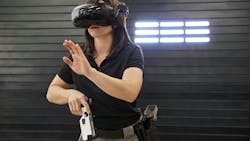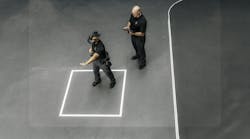A New Way to Train: Making TASER Training a Virtual Reality
In just a matter of years, Axon’s VR arm has grown from a supplemental tool, that focused solely on community engagement training, to a vital tool that can now be used for realistic TASER training that allows law enforcement agencies to have officers fire virtual rounds instead of discharging live cartridges
This article appeared in the May/June issue of OFFICER Magazine. Click Here to subscribe to OFFICER Magazine.
Thi Luu, Vice President and General Manager of Virtual Reality for Axon, and Andy Wrenn, Vice President and Head of Training for Axon, spoke to OFFICER Magazine during Axon Week in Miami Beach, Florida, about how the VR training program has advanced, and where the company sees it going in the future.
The evolution of VR
Back in 2018, Axon launched its Community Engagement VR Training program. In 2022, the VR program advanced even further with the introduction of TASER training, but it wasn’t until late last year that the company was able to address a lot of the concerns expressed by users, with the release of the TASER 7 and TASER 10 VR controllers. The new controllers are joined by the Axon VR Simulator training that includes immersive TASER Range Skill exercises, which offers six different options including distance, clothing, alternate positions, draw repetition and timed deployment.
One of the main ideas behind the Axon VR training was giving the ability to officers to have more training with very little setup. While screened simulators can still provide valuable training to officers, not all law enforcement agencies have the space to house them, and it forces officers into a centralized location, away from other training.
“Our solution is very portable,” says Luu. “You can throw the headset and the controller and maybe a couple spare batteries into a backpack or duffel bag and bring that to where your officers are versus having all your officers take time out their very busy days to go to a centralized facility.”
Axon will soon be launching a handgun VR controller, along with Virtual Reality-Based Training Live Action or VRBT Live Action. Reality-Based Training is common for law enforcement agencies but requires a lot of resources including actors and officers who reenact scenarios in a large area. “It can be very resource intensive for officers and trainers to be able to do that,” says Luu. “Typically, we hear from agencies that they do the RBT scenarios about once per year. By offering something that is similar in VR, hence VRBT, they can do that any time. You don’t need much space. All you really need is the headset and the controller and you can get into training in a minute,” she says.
She noted that the initial plan is to not use the handgun controller for marksmanship or qualification. “We’re really using the firearm as an additional tool on the officer’s belt to showcase how do they pick, what’s the right weapon to use?” she says. “It will really focus on the cognitive skills and the decision-making more than pure firearms training.”
She added that there will be some handgun-focused exercises supported by the simulator including one called Handgun Targets where the officer will be presented with multiple targets, and some will be different shapes, colors and numbers and the officer will be told which ones to shoot. “Again, that’s more about building those decision-making skills, in which you can identify the right target. Then, we will also be offering another exercise that’s a transition exercise where officers will constantly have to transition between the handgun controller and the TASER controller. Transitioning weapons and holstering and unholstering, that’s something where you want to build a lot of muscle memory and high repetition. If you’re slow and you choose the wrong weapon, the results can have very bad outcomes in the field.”
Building a foundation
When Wrenn became Axon's head of training in 2021, he observed there were still a number of law enforcement agencies that had officers shoot two cartridges into a cardboard target and counted that as their TASER training. “They would go through the lecture series and then go to that live fire, but there was no decision-making, no stress,” he says. “There wasn’t a use-of-force environment. So, we wrote the manufacturer recommendation in 2021 to simply read: ‘Train in the environment you’re actually going to operate the tool in.’ ”
Wrenn noted that through the use of Reality Based Training, officers have to make decisions on threat management and distance management and other facets of the environment. “You’ve probably seen the TASER suits that agencies use to run scenarios. Some of them are communication scenarios where we just want compliance, and we get compliance by communicating effectively. Some of those are lethal scenarios. Some of them are non-lethal scenarios. Some of them are weapon transition scenarios,” he says. “The idea is that a police officer shouldn’t have any expectation of what they’re going to encounter in training, because that’s what happens in the street, and they shouldn’t have any indication of what tools they’re going to be using when they encounter this scenario.”
According to Wrenn, Axon has been successful over the last several years in getting agencies to adopt certification models that include RBT, but noted that style of training does have its challenges and that it requires manpower and resources. “It takes a lot of role players. Sometimes people get hurt because we’re moving very dynamically. It’s a lot to run RBT, and it’s very important; we cannot run a successful program without it,” he says. “Over a year, an officer now, because of where we are with VR, should be firing thousands of cartridges. That’s what we can do if we scale that training very quickly. Now, we put our RBT, all the decision-making criteria, all the decision-making modeling. Putting people under stress, we can do that in VR, we can give that kind of aspect and experience.”
Luu says that hundreds of law enforcement agencies are currently using Axon VR Training currently. Since the TASER 10 launched, agencies are using the TASER Range Skills in VR to help build proficiency because it’s very different from how they used to deploy a TASER 7. “We have had agencies running all their officers through those range skills and deploying tens of thousands of cartridges in VR. If they had done that much with live cartridges, it would have been very cost prohibitive. We are seeing agencies use those TASER range skills to help train the officers on TASER 10 as they roll it out if they were upgrading from TASER 7, but even for our TASER 7 customers as part of their annual TASER certifications, they’re putting people through this training.”
Looking toward the future
With the expense of live TASER training being so high, Wrenn conceded that there may be a time in the future where Axon VR Training may eventually take the place of live training: “We’re thinking about that right now,” he says. “When does that happen? At one point in time, is the technology so far better than in person from a qualification perspective where it doesn’t do as well in training to be in live fire.”
Axon moved this year to make VR a core component of certification moving forward, starting with master instructor schools. “When you go through a master instructor school, it’s a five-day experience,” he says. “We do a lot of instructor development, and we teach them how to teach these different specific drills. There’s now a VR certification component built in. So, you cannot graduate from master instructor school until you complete the VR component.”
According to Wrenn, the next step is pushing the VR TASER training to all of the company’s instructor courses. There’s about 700-800 of courses per year, and Axon is looking to add VR to the course load next year. “We’re thinking about these things, and I can totally see a point in time in the next handful of years when you may fire a couple of live cartridges once a year to maintain a certification, but the majority of your work done in training happens in VR.”
About the Author
Paul Peluso
Editor
Paul Peluso is the Managing Editor of OFFICER Magazine and has been with the Officer Media Group since 2006. He began as an Associate Editor, writing and editing content for Officer.com. Previously, Paul worked as a reporter for several newspapers in the suburbs of Baltimore, MD.



